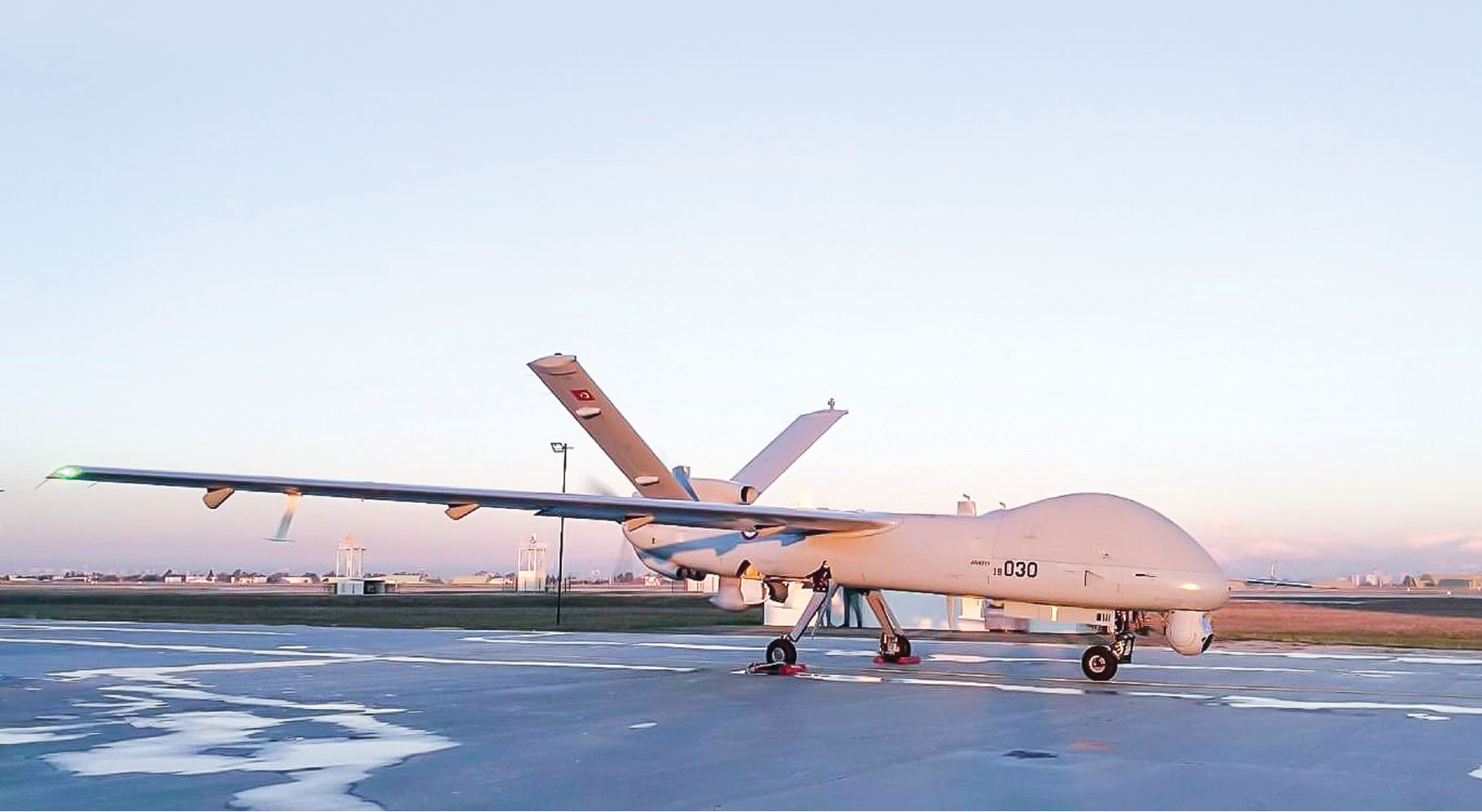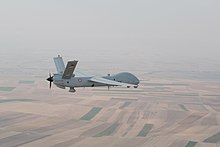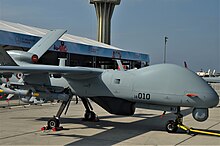You are using an out of date browser. It may not display this or other websites correctly.
You should upgrade or use an alternative browser.
You should upgrade or use an alternative browser.
TAI Anka
- Views Views: 6,111
- Last updated Last updated:
Navigation
-
Contents
ANKA 
Overview Role: MALE UAV Nation of Origin: Turkey Manufacturer: TUSAS(TAI) Introduction: Specifications Wingspan: 17.5 m Length: 8.6 m Weight: Propulsion: TEI PD-170 Armament: Precision Guided Bombs - Laser Guided Rockets - Anti-tank missiles Sensors: • ISR Payloads - EO/IR/LD/LRF Camera - SAR/GMTI-ISAR Radar - Wide Area Surveillance Camera • EW (Electronic Warfare) - ESM / EA (Electronic Support Measure and Electronic Attack) - ComJam (Communication Jamming) Combat Radius: 250+ km and SATCOM Max Speed: Max Altitude: 30,000 ft ( Endurance: 30+ Hours @ Other Users: Turkey,Tunusia Conflicts:
The TAI Anka is a family of unmanned aerial vehicles (UAV) developed by Turkish Aerospace Industries (TAI) for the Turkish Armed Forces. The first version, Anka-A, was classified as a medium-altitude long-endurance unmanned aerial vehicle (MALE UAV). Envisioned in the early 2000s for tactical surveillance and reconnaissance missions, further versions evolved into a modular platform with synthetic aperture radar, precise weapons and satellite communication. The drone is named after phoenix, a mythological creature also called Zümrüd-ü Anka in Turkish.
Design

Anka in flight
The TUAV system consists of three air vehicles (A/V), a ground control station (GCS), a ground data terminal (GDT), an automatic take-off and landing system (ATOLS), a transportable image exploitation system (TIES), a remote video terminal (RVT), and various ground support equipment (GSE).[citation needed]
The TUAV system, which is designed for night and day missions including adverse weather conditions, performs real-time image intelligence, surveillance, reconnaissance, moving/stationery target detection, recognition, identification, and tracking missions.[3]
While the TUAV system has an open architecture to support other payloads and missions, the air vehicle is typically configured to carry the following payloads:[4]
- Electro-optic color day camera (EO day TV)
- Electro-optic/forward-looking infrared/laser rangefinder/laser designator and spotter camera (EO/FLIR/LRF/LDS)
- Synthetic-aperture radar/ground moving target indicator (SAR/GMTI)
- Inverse synthetic-aperture radar (ISAR)
All airborne and ground-based flight control software is developed by TAI while payload and other relevant hardware and software items are aimed to be developed by national sub-contractors, such as Aselsan, AYESAS, and MilSOFT.
UAV operations are supported by highly sophisticated ground control system with complete redundancy, developed by a domestic defence company Savronik.[6] Whole mission segments of the air vehicle can be managed, monitored and controlled by a GCS. A pre-programmed mission plan can be loaded before the flight begins or can be altered during the flight. All the imagery stream of the payloads can be displayed and recorded in real time and all the payloads can be controlled from the GCS. ATOLS allows the air vehicle to perform its operation without operator intervention, including the most critical phases which are landing and take-off.[citation needed]
In TIES, valuable intelligence information can be obtained by the analysis of bulky imagery data. TIES operators can initiate intelligence missions prior to or during flight. Refined information flows to the upper command layer in order to assist the headquarters to monitor a network of TUAV systems and benefit from the gathered intelligence information. Another interface of the TUAV system is the RVT, with which other friendly units who are close to the target area can utilize the real time imagery that TUAV air vehicle broadcast
Armaments
- L-UMTAS (Long Range Anti tank Missile System)
- MAM: MAM-C and MAM-L precision-guided munitions
- Roketsan Cirit (70 mm Missile System)
- TUBITAK-SAGE Bozok Laser Guided Rockets
- TUBITAK-SAGE TOGAN - Air-to-surface launched 81 mm mortar munition
Development

Anka-S at Teknofest 2019
The contract regarding the development of an indigenous Medium Altitude Long Endurance (MALE) Unmanned Aerial Vehicle (UAV) system for the reconnaissance requirements of the Turkish Armed Forces became effective on 24 December 2004. Within the framework of the program, a total of three prototypes and ground systems will be designed, developed, manufactured, and tested by mid-2011 as part of the prototype development phase. Subsequently, in 2012, the serial production phase of Anka-A would be launched and additional 10 systems (meaning 30 air vehicles) built for the Turkish Air Force.
- On 30 December 2010, the first TAI Anka unmanned aerial vehicle completed its debut flight, with 14 minutes of cruising, at 15:45 local time. It crashed after 15 minutes.[8] Defence Minister Vecdi Gönül confirmed the flight.
- On 5 May 2011, TAI released the test flight video of Anka. Anka-A flew a test and calibration mission of 2h 30m.
- Turkish Aerospace Industries announced on 25 October 2011 that the Anka had successfully completed its subsequent flight and landing tests and that it will now be in the Turkish Air Force inventory in 2012 that is much earlier than expected. Footage released by TAI also shows the Anka landing successfully putting all speculation abouts its crash landings to rest.
- On 22 November 2011, the Anka held the follow-up test flight for 6 hours at 20,000 ft. The vehicle demonstrated its automatic take-off and landing system for the first time.
- On 5 January 2012, Defence Industry Executive Committee authorized Undersecretariat for Defence Industries to commence talks with Turkish Aerospace Industries for the serial production of 10 Anka vehicles.
- On 27 September 2012, an Anka prototype crashed during a flight test due to a technical problem.
- On 20 January 2013, Anka completed acceptance tests by the Turkish Air Force. The final acceptance tests were conducted near Ankara, and involved an 18‑hour‑long, 200 km ring flight. The tests also included a night landing in adverse weather conditions. The Anka has flown more than 140 hours and reached and altitude of 26,000 feet.
- On 13 May 2013, the Pakistan Aeronautical Complex, Kamra handed over the first batch of Anka UAV parts to Turkish Aerospace Industries during IDEF 2013 at Istanbul, Turkey.[18][19]
- On 6 December 2013, another Anka UAV crashed in southeastern Turkey during a day flight.
- On 30 January 2015 it was announced by the Undersecretariat of Defense Industry that the new generation high performance Anka Blok B unmanned aerial vehicle completed the tests of different autopilot and landing modes in the first flight with automatic take-off and landing
- Anka intensely used during Operation Euphrates Shield[22][23] While the aircraft participated in many counter-terrorism operations within the Turkish Armed Forces, it also played an active role during operations in Syria and Iraq such as Operation Olive Branch, Operation Claw (2019–2020), Operation Peace Spring, Operation Spring Shield, Operation Kiran and Operations Claw-Eagle and Tiger.In this way, useful experiences was made in the development of the aircraft.
- The first deliveries of the ANKA-S version began in early 2017.
- The unmanned target drone Şimşek, produced by TAI, integrated into ANKA UAV with a catapult, was launched from the Anka B class. Thus, for the first time, a target unmanned aerial vehicle was launched from a MALE class UAV.
- Istanbul based CTech company, has developed portable satellite communication systems with domestic facilities. The system was first integrated into TUSAŞ (Turkish Aerospace) production Anka-S UAVs.
Configurations
Turkey's Directorate for Defence Industries has been stressing advanced variants of the Anka with larger payload capacity, extending Block A capabilities to the features like:
- SATCOM
- SIGINT
- Air-to-ground and air-to-air missile integration
Variants
Anka +A
On 19 July 2012, the Turkish Defense Industry Executive Committee (SSIK) announced that Turkish Aerospace Industries had commenced research and development for the design and development of a "hunter killer" High-Altitude Long-Endurance version of the Anka UAV, named the Anka +A. It was planned that Anka +A will carry Cirit missiles of Turkey's ROKETSAN. The weight of Anka +A UCAV would be more than 4 tons compared to Anka Block A's 1.5 tons. It was highly expected that the UCAV would be presented to public in the events of IDEF'13 on 7–10 May 2013.[29][30][31][32]
Anka-B
Anka-B with SAR Radar
On 30 January 2015, the Anka-B completed its maiden flight successfully. Anka Block B is an improved version of the Anka Block A. The UAV carries an Aselsan synthetic aperture radar/ground moving-target indicator payload in addition to the platform's electro-optical/infrared sensor. During the maiden flight, Anka-B successfully performed "basic shakedown" and auto-landing. The Anka Block B also has a greater payload capacity than that of the Anka-A which includes SAR/ISAR/GMTI radar (in addition to the cameras of Anka A) that obtains and remits high resolution intelligence data back to base. The Anka Block B paved the way for weaponisation of the platform in the foreseeable future. Anka Block B passed 30.000 feet, 26 hours and 200 km radius during the test flights. Turkish Air Force ordered 10 Anka Block B in 2013 at a cost of $300 million.
Anka-S
Anka-S with modified radome for SATCOM
Anka-S is a serial production configuration of Anka. It is equipped with a SATCOM antenna and a national flight control computer. Like Block A and Block B, Anka-S will be powered by Thielert Centurion 2.0S. On the other hand, Turkish Engine Industries (TEI) has been developing a national engine, capable of running with diesel and JP-8 jet fuel.
On 25 October 2013, Turkish Undersecretariat for Defence Industry (SSM) ordered 10 Anka-S UAVs and 12 ground control stations for $290 million ($220.6 million + TRY 137 million). The UAVs would be delivered in three batches (2+4+4).
In 2016, media reported that the TAI was manufacturing 4 Anka-S UAVs for the armed forces. The first two of these aircraft were to be equipped with StarFIRE 380-HDL FLIR payload. However, these would be replaced with Aselsan CATS later on.
On 17 August 2018, Directorate for Defence Industries announced that the Anka-S completed its first live fire tests. The platform was tested with MAM-L ammunition developed by the Roketsan.[37] In September, Ismail Demir, director of the Turkey's defence industry authority, shared a picture of the first Anka-S equipped with Aselsan CATS optical system.[38] TAI delivered 2 more Anka-S to Turkish Air Force in September 2018,[39] increasing the Anka-S inventory of Turkish Air Force to 8 aircraft. TAI is planning to deliver a total of 10 Anka-S to Turkish Air Force before 2019.
In August 2018, the Anka-S carried out Turkey's first "satellite-controlled airstrike" according to the Turkish Presidency of Defense Industries.
In December, an Anka completed its first flight with an engine produced domestically. In 2019, the Anka broke its endurance records, flying longer than 24 hours.
Although Ankas have an operational range of about 100 miles, the Anka-S (satellite-enabled) is capable of flying beyond "line of sight".
Anka-I
Electronic warfare and intelligence UAV made for the National Intelligence Organization. Equipped with electronic warfare and intelligence systems (ELINT and COMINT)

Operators
Turkey
- Turkish Air Force – 43 active
- Turkish National Intelligence Organization – Anka-I variant
- Turkish Naval Forces - 6 delivered with SAR
- Gendarmerie General Command - 2 Anka-B and 6 Anka-S units used by Elazig Gendarmerie UAV command
Tunisia
- A contract was signed in March 2020 for 3 Anka-S and 3 command centers at $USD 80 million
